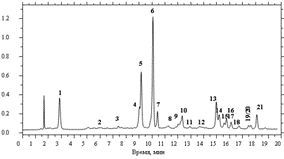CHEMICAL COMPOSITION OF GERANIUM WLASSOVIANUM (GERANIACEAE)
UDC 58:633.88(571.54)
Abstract
The article presents the results of experimental findings concerning the study of the chemical composition of above-ground and underground parts of Geranium wlassovianum. The amount of number of tannins into the plant matter gathered during the blooming period is 19.45±0.04% in the root system and 20.93±0.03% in the above-ground part of a plant. Tannins are referred to phenolic compounds. For qualitative determination of peculiar phenolic compounds the HELC (high-efficiency liquid chromatography) method was used. This method allowed to determine 21 compounds from the aqueous extract of the above-ground parts and 11 compounds from the aqueous extract of the underground parts of the Geranium wlassovianum. 8 compounds were found both in the shoot system and in the root one, 13 substances are contained only in the grass, 3 substances were found only in the underground plant parts. During the study, the elemental composition of a plant was identified, as a result 22 chemical elements were found out. For 6 elements the root barrier index is lower than one that points at barrier-free transition of elements from a root system to an above-ground parts of a plant. The rest 16 elements meet the barrier during transition (in the range from 1 to 10), that is the concentration of these 16 elements is higher in the underground part than in the grass part. The variety of the chemical composition and quantitative content of the chemical elements in the plant matter of the species that is under the research depend on different natural factors.
Downloads
Metrics
References
Antsupova T.P., Dashiyeva Zh.D., Yendonova G.B., Zhapova O.I., Il'ina L.P., Pavlova Ye.P. Lekarstvennyye ras-teniya Buryatii v nauke i praktike. [Medicinal plants of Buryatia in science and practice]. Ulan-Ude, 2015, 150 p. (in Russ.).
Minayeva V.G. Lekarstvennyye rasteniya Sibiri. [Medicinal plants of Siberia]. Novosibirsk, 1991, 431 p. (in Russ.).
Telyat'yev V.V. Poleznyye rasteniya Tsentral'noy Sibiri. [Useful plants of Central Siberia]. Irkutsk, 1985, 384 p. (in Russ.).
Rastitel'nyye resursy SSSR: Tsvetkovyye rasteniya, ikh khimicheskiy sostav, ispol'zovaniye; Semeystva Rutaceae – Elaeagnaceae. [Plant resources of the USSR: Flowering plants, their chemical composition, use; Families Rutaceae–Elaeagnaceae]. Leningrad, 1988, 357 p. (in Russ.).
Opredelitel' rasteniy Buryatii [Key to plants of Buryatia], ed. O.A. Anenkhonov. Ulan-Ude, 2001, 672 p. (in Russ.).
Il'ina L.P., Antsupova T.P. Mezhdunarodnyy nauchno-issledovatel'skiy zhurnal, 2016, no. 5(47), pp. 73–74. DOI: 10.18454/IRJ.2016.47.083. (in Russ.).
Il'ina L.P., Antsupova T.P. Yestestvennyye i tekhnicheskiye nauki, 2018, no. 4, pp. 27–34. (in Russ.).
Il'ina L.P., Antsupova T.P. Botanika v sovremennom mire: trudy XIV S"yezda Russkogo botanicheskogo obshchestva i konferentsii. [Botany in the modern world: Proceedings of the XIV Congress of the Russian Botanical Society and Conference]. Makhachkala, 2018, vol. 1, pp. 130–132. (in Russ.).
Rastitel'nyye resursy Rossii: Dikorastushchiye tsvetkovyye rasteniya, ikh komponentnyy sostav i biologicheskaya aktivnost'. T. 3. Semeystva Fabaceae – Apiaceae [Plant resources of Russia: Wild flowering plants, their composition and biological activity. Vol. 3. Fabaceae – Apiaceae families], ed. A.L. Budantsev. St. Petersburg, Moscow, 2010, 601 p. (in Russ.).
Gosudarstvennaya farmakopeya Rossiyskoy Federatsii, XIV izd. [State Pharmacopoeia of the Russian Federation, XIV ed.]. Moscow, 2018, vol. 2, pp. 1815–3262. (in Russ.).
Khimicheskiy analiz lekarstvennykh rasteniy [Chemical analysis of medicinal plants], ed. N.I. Grinkevich, L.N. Safronich. Moscow, 1983, 176 p. (in Russ.).
Zverev A.A., Zefirov T.L. Statisticheskiye metody v biologii. [Statistical methods in biology]. Kazan', 2013, 42 p. (in Russ.).
Chuparina Ye.V., Martynov A.M. Zhurnal analiticheskoy khimii, 2011, vol. 66, no. 4, pp. 399–405. (in Russ.).
Zhamalova D.N., Pulatov S.O., Kurbaniyazova G.T., Zhabborov A.M., Tazhiyeva F.A. Universum: khimiya i biologi-ya, 2019, no. 10(64). URL: http://7universum.com/ru/nature/archive/item/7865. (in Russ.).
Razarenova K.N., Sipkina N.Yu., Zhokhova Ye.V. Butlerovskiye soobshcheniya, 2012, vol. 31, no. 7, pp. 93–97. (in Russ.).
Razarenova K.N., Zhokhova Ye.V. Khimiya rastitel'nogo syr'ya, 2011, no. 4, pp. 187–192. (in Russ.).
Bubenchikov R.A., Pozdnyakova T.A. Mediko-sotsial'naya ekologiya lichnosti: sostoyaniye i perspektivy: Materialy XII Mezhdunarodnoy konferentsii. [Medico-social ecology of personality: state and prospects: Proceedings of the XII International Conference]. Minsk, 2014, pp. 13–15. (in Russ.).
Lovkova M.Ya., Rabinovich A.M., Ponomareva S.M., Buzuk G.N., Sokolova S.M. Pochemu rasteniya lechat. [Why do plants heal]. Moscow, 1990, 256 p. (in Russ.).
Siromlya T.I., Zagurskaya Yu.V. Khimiya rastitel'nogo syr'ya, 2019, no. 2, pp. 179–187. DOI: 10.14258/jcprm.2019023965. (in Russ.).
Razarenova K.N., Zhokhova Ye.V., Belyayeva A.I. Rastitel'nyye resursy, 2013, vol. 49, no. 1, pp. 118–124. (in Russ.).
Bityutskiy N.P. Mikroelementy i rasteniye. [Microelements and plant]. St. Petersburg, 1999, 232 p. (in Russ.).

Copyright (c) 2022 chemistry of plant raw material

This work is licensed under a Creative Commons Attribution 4.0 International License.

This work is licensed under a Creative Commons Attribution 4.0 International License.
The authors, which are published in this journal, agree to the following conditions:
1. Authors retain the copyright to the work and transfer to the journal the right of the first publication along with the work, at the same time licensing it under the terms of the Creative Commons Attribution License, which allows others to distribute this work with the obligatory indication of the authorship of this work and a link to the original publication in this journal .
2. The authors retain the right to enter into separate, additional contractual agreements for the non-exclusive distribution of the version of the work published by this journal (for example, to place it in the university depository or to publish it in a book), with reference to the original publication in this journal.
3. Authors are allowed to post their work on the Internet (for example, in a university repository or on their personal website) before and during the review process of this journal, as this may lead to a productive discussion, as well as more links to this published work.











